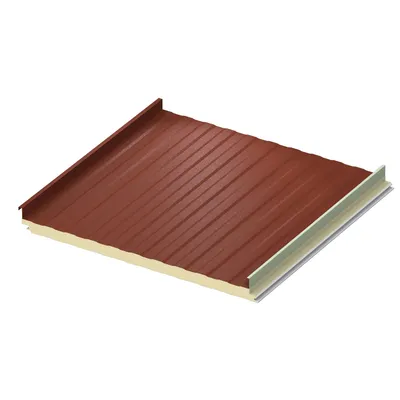


Metl-Span’s CFR is an insulated standing seam panel for metal roofs. This innovative all-in-one composite insulated standing seam roof panel design combines durable interior and exterior faces with a foam core. The outer profile consists of 1/8″-deep embossed boards and can be used on roof slopes as low as 1/2″ : 12″.
The unique advantage of CFR composite roofing panels is that they feature factory-cut panel notches and crimped ends, eliminating the need for additional, time-consuming labor. Factory-installed backing plates at the overlaps eliminate the need for pre-drilling for special fasteners. Its standing seam exterior also offers unrivalled waterproofing performance, making it an unrivalled roofing system.
CFR panels can also be used as roofing for cold rooms, freezers, food processing warehouses and dry goods warehouses. It’s the ideal roofing panel when temperature control and longevity are essential. Contact our representatives today for more information.
36″, 42″
9′-6″ à 53′-0″
U-factor (BTU/h-ft2*fahrenheit)
Panel width: 42″ at 35 degrees
2″ = 0.065
2.5″ = 0.052
3″ = 0.044
4″ = 0.033
5″ = 0.027
6″ = 0.022
R-value (h* ft2*F/BTU)
Panel width: 42″ to 35 degrees
2″ = 17.5
2.5″ = 21.9
3″ = 26.2
4″ = 35.0
5″ = 43.7
6″ = 52.5
Exterior: G-90 galvanized steel or
AZ-50 aluminum-zinc-coated steel in 24- and 22-gauge; or
AZ-55 aluminum-zinc-coated steel with a
clear acrylic coating in 24-gauge.
Outside profile: 2″ high seam with
Mesa profile between seams, embossed Inside face: G-90 galvanized or coated
aluminum-zinc AZ-50
steel in 26, 24 and 22 Ga.
Inner profile: Mesa, nominal 1/8″, deeply embossed or
non-embossed
Single-lock standing seam mechanically sewn with concealed clip at
outer side seam. The inner side seam is a single tongue-and-groove lock.
What customers can’t find doesn’t exist. Display a clear and detailed list of your services. And don’t forget to offer a premium service.
Thermal values, including R-value and U-value, are crucial metrics used in building construction and insulation to quantify the ability of materials to resist heat transfer. Here’s what each means:
1. ** R** value:
– The R-value measures a material’s thermal resistance, indicating its ability to resist heat flow. The higher the R value, the better the insulation.
– It’s a measure of thermal resistance per unit area. So the thicker the insulation (or the higher its thermal resistance), the higher the R-value.
– The R-value is commonly used in the USA, Canada and some other countries to specify insulation performance for various building components such as walls, roofs and floors.
– Higher R-values are desirable in colder climates to minimize heat loss in buildings during winter.
2. ** U coefficient**:
– The U-value is the thermal transmittance of a material, indicating the rate of heat transfer through it. The lower the U-value, the better the insulation.
– Unlike the R-value, which measures resistance, the U-value measures the amount of heat that can pass through a material.
– This is the reciprocal of the R-value. So a material with a high R-value will have a low U-value.
– The U-value is commonly used in Europe and other parts of the world to quantify the insulating properties of windows, doors and other building components.
– Lower U coefficients are desirable in hot and cold climates to reduce the amount of heat transferred through building components, thus improving energy efficiency.
In summary, R-value and U-value are complementary metrics used to assess the insulating properties of materials. While the R-value measures thermal resistance, indicating a material’s ability to prevent heat flow, the U-value measures thermal transmittance, indicating the amount of heat that can pass through a material. Both are essential for designing energy-efficient buildings and choosing appropriate insulation materials.
Customized solutions to meet your needs and expectations